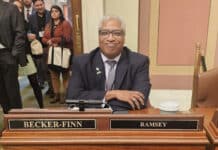Following the modern and “woke” trend in which companies are taking part, the organization I belong to formed a “Diversity and Inclusion Council” earlier this year. You might ask, “Well Alyssa, what’s wrong with diversity and inclusion?” To that I say, nothing. Nothing is wrong with it because it is, in and of itself, nothing of substance. Let me explain myself. Diversity is defined in the Merriam-Webster dictionary as “the condition of having or being composed of differing elements: variety. Especially: the inclusion of different types of people in a group or organization.” If you have more than one person in a group, you automatically have diversity. No one person shares the exact same life experience or thought process as another.
Diversity in the modern era has transformed into intersectional diversity. Your skin color, religion, sexual orientation, and any other identity having little to no effect on your character have taken center stage. The more people on the spectrum of intersectional identity, the more the supposed diversity and inclusivity. There is a false assumption that if an institution is too homogenous it is intolerant and incompetent. Diversity and inclusion are not dependent on one another. Inclusion is not measured by the level of diversity. Inclusion is measured by the character of each individual and their cohesive nature when placed within an organization or group. My company was just as inclusive before the Diversity & Inclusion Council as it is now.
Having a higher level of diversity doesn’t make a company better. Having competent workers who are best fit for their given positions does. A company whose workforce is 50% white and 50% black has more “diversity” than a company that is 100% black. Does it mean the company with an all-black workforce is less proficient? Of course not. Without individual data and company information, we have no idea which is the better performing company and due to what factors. Diversity is net-neutral. It has neither a positive or negative effect on success. Work ethic, character, and skill determine the level of your achievement, not your ethnicity, sexual orientation, or identity trait.
The work environment is far from the only place we’ve seen overrun by the diversity police. Our school systems and Hollywood have been flooded by calls for “equal” and “fair” representation of varying minority groups. Universities are altering their admission standards in order to meet diversity quotas. Administrations are vying for faculty with certain skin colors, religion, and sexual identities in an attempt to look like a more “cultured” and “tolerant” establishment. Harvard is in the middle of a lawsuit for not admitting Asians because admission on merit would result in too many Asians getting into the university. Therefore, tilting the diversity levels in an unfavorable direction. In media, there is backlash if a movie or show doesn’t have at least “one of everything” – gay, lesbian, transgender, Muslim, Hispanic, black, an amputee, a black trans Muslim missing a leg. There will always be a need for more diversity in progressive culture. Feminists were angry that Marvel didn’t have a lead female character. In comes Captain Marvel. But now the progressive crowd is angry there isn’t LGBTQ+ representation among the superhero franchise. It’s never enough.
The demand for diversity doesn’t stop even if the minority achieves inclusion to the level they represent in the population. If that were the case, we would see significantly fewer characters of minority status based on pure statistics. No, the argument for diversity in media is relatability. There’s this strange notion that in order to relate to a character you have to look exactly like them. If we only relate to someone based on their external appearance or sexual preference, we need to reevaluate our values and priorities.
In 2019, we should have progressed far enough to appreciate that our identity is based on the content of our character, not our race, religion, sexual orientation, or color of our skin. And that diversity of ideas and thought far outweigh the diversity of looks and preferences. The most interesting things about a person is not who he loves, how much money he makes, where he was born, how he worships, or what he looks like. So, why do we define ourselves by these?
A diversity and inclusion council will not make for a better company, school, or a better movie. The United States is the most diverse and inclusive nation on the planet because your intersectional identity doesn’t matter. What matters is what you bring to the table. Your character, work ethic, and virtue are what matter. Diversity pandering doesn’t bring inclusion. It points out the hollow characteristics that separate us on an irrelevant level. Requiring diversity in the name of inclusivity achieves the exact opposite of its intended unification. Because it will never be enough. We are individuals. Treat us as such and we will choose unity.
***
Do you like Alpha News? Help us reach more people in 2019 by donating today.
Alyssa Ahlgren
Alyssa has her Bachelor’s in Business Administration and currently works as an analyst in corporate finance. She grew up in northern Wisconsin and is a former collegiate hockey player. Alyssa is pursuing her passion for current events and politics through writing and being an advocate for the conservative movement.


















